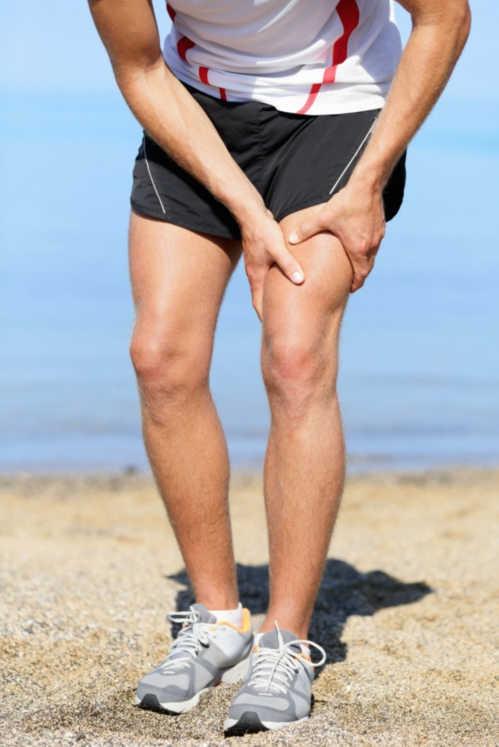
There are two main types of muscle cramps. If you can identify which one you are experiencing you may be able to stop cramping sooner and prevent future cramps.
Localized Muscle Cramping
Localized muscle cramps happen suddenly when a muscle is overworked and tired.
They feel like: constant pain.
Risk factors include: several factors may contribute to localized muscle cramping including: older age, history of cramping, metabolic disturbances, poor conditioning (or increasing the intensity of your training before you are ready) and not stretching.
Treatment: for this type of cramping should include passive stretching, massage, active contraction of the antagonist or opposing muscle group (for instance, if your hamstrings are cramping, contract your quads), and icing.
Prevention: Stretching (hold your stretch for at least 30 seconds), using proper movement patterns (biomechanics) and making sure you are conditioned before increasing the intensity of your training.
Exertional Heat Cramps
Exertional heat cramps are due to extensive sweating and low sodium levels from not consuming enough sodium and/or losing too much sodium through sweat.
They feel like: initially you may feel brief, spontaneous contractions that take time to develop followed by debilitating, widespread muscle spasms.
Risk factors include: high sweat rate, little sodium intake (especially if you lose a lot of sodium through sweat or over consume water or other no or low sodium drinks).
Treatment: replacing both fluid and sodium losses as soon as you start cramping. You can use an electrolyte replacement product or table salt! IVs are sometimes used to expedite this process. Massage and ice can also help relax the muscles and relieve discomfort.
Prevention: if you are a “salty sweater” – you see white salt crystals on your clothes, face or other parts of your body, be sure to salt your food prior to training and competing and consume enough sodium in your sports drink to prevent excessive sodium losses.
If you know what type of cramps you are prone to, you can better incorporate prevention methods and have treatment options readily available to stop cramping as soon as possible [ice, sports drinks, electrolyte products, table salt (restaurant salt packets in a ziplock bag always come in handy), a good athletic trainer nearby etc.].
As a review, here are your prevention strategies for cramping:
- If you have a history of heat cramping, know that your cramps will likely reoccur at some point during training or competition.
- Make sure you are conditioned before increasing the load or intensity of your training.
- Incorporate stretching or hot yoga into your training regimen.
- Give your body time to adjust to changes in elevation, heat and humidity.
- Salt your food!
- Do not over-consume water or any other low or no sodium beverage or you’ll dilute your blood sodium level and set yourself up for cramps.
- Weigh yourself pre- and post- training. For each lb lost, consume 20 – 24 oz of an electrolyte-replacement drink.
- Work with a sports dietitian or athletic trainer (ATC) to develop a hydration-electrolyte plan that specifically meets your needs. Sports drinks do not contain enough sodium for salty sweaters and those prone to exertional heat cramps.